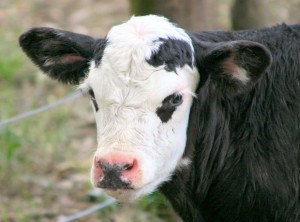A Little Research Can Prevent a Lot of Animal Cruelty

I don’t eat a lot of meat, but I am not a vegetarian, nor do I have any qualms against people eating meat; I simply have issues with the way many animals are treated before they reach our dinner tables. Killing an animal for food is a basic instinct dating back to prehistoric humans.
It occurs naturally in the animal kingdom and has been present with humankind through all the ages. The difference now is how the animals are treated before they become food. Many of the current methods of animal production for food are indeed nothing short of murder. However, there are alternatives that allow one to have meat without torturing animals in the process.
Animal Cruelty Among Chickens
The large majority of chickens, whether for meat consumption or eggs, find themselves crammed into tiny cages 24 hours a day. The chickens are forced to bear deformed feet from spending all their lives standing on the cage wire. Cages are stacked atop one another meaning that the feces from the higher cages drop onto the chickens below.
These chickens never see the light of day. Egg-laying chickens are sorted at birth, the females being de-beaked and stuffed into cages while the males are quickly disposed of by suffocation or being tossed into a grinder while they are still alive.
Beef And Dairy Cows
Cows often have it bad whether they are meat or dairy animals. Many beef cattle are raised inside barns and never seeing the light of day. They sleep in, and consequently ingest, their own droppings. They are shot up with growth hormones and fed diets of animal protein, which sometimes include ground sheep carcasses, in order to fatten them. This is not part of their natural diet.
Dairy cows are kept in small stalls on concrete floors. They are given hormones to make them produce extra milk and are then forced to endure being milked three times a day. This over-milking exhausts them so that they die young. Naturally cows can live to be around 25 years old (my cow Bittersweet is currently 17 years old and lively as ever), but over-milked dairy cows rarely live beyond the age of 6 or 7.
Dairy calves are taken from their mothers at birth and can often be heard crying for their mothers. Those calves are kept chained to tiny little huts about the size of doghouses, until they are old enough to be milked themselves. In the case of male calves, they are often used for veal and calf liver. They are given a chain about 3 feet in length and tiny calf huts.
There is no room to move in these sheds, as muscle deterioration makes the veal more tender, the way customers prefer it. Their mothers’ milk is taken for human consumption, so the calves are fed milk replacement, which is often deficient of their needed nutrients. They are often starved and dehydrated intentionally. After a few months of this brutal treatment, they are sent to the slaughterhouse, but many die from malnutrition before then.
Duck and Geese Livers
Perhaps the greatest source of animal torture, comes from what some people consider a delicacy; the livers of geese and ducks. Geese and ducks are force fed to get their livers nice and plump. Their jaws are pried open so they cannot protest as food is inserted and they are overfed. Many of these animals’ stomach explode from this treatment.
Some Alternatives to Help End Animal Cruelty
Bottom line is, never eat veal or duck liver as there is no one who treats these animals humanely. For the others, however, there are humane alternatives. Organic food is often better than non-organic, but don’t necessarily believe just the labels. There are different levels of “organic” and just because something is labeled organic does not mean it has been treated humanely. Instead look for free range chickens and beef. Look for eggs from free-range chickens. Find local milk suppliers who do not milk their animals more than twice a day. Scout around for farmers who do not use any hormones on their animals.
This is not foolproof, as some people do label meats free-range when they are most certainly not, but for the most part, it is a better way to go. The best bet of all, however, is to either raise it yourself or get it from a local farm market. The farmers selling meat at these markets usually have smaller spreads than the big agribusinesses and thus their animals are raised in better conditions. Just look around the farm and notice if the animals are truly free range, running about the field. Many good farmers are glad to show their farms, so people know the animals are being raised in good conditions. A little research in knowing where one’s food is coming from can mean a lot in the way of better treatment for animals.
By Amber Reifsteck, The Woodland Elf
The information provided on this website is for general information purposes only. If you choose to rely on the information on this website, you do so at your own risk and you assume responsibility for the results. (Full disclaimer here)
Enjoy this post? Click here to subscribe by email and get new posts delivered to your inbox.Ads by Google









Amber, congratulations and thank you for looking into this heartbreaking issue. I suffer like you do at the inhumanity. For 15 years, i was a vegetarian. I’m now the co-owner of a restaurant that serves humanely raised beef, pork, chicken, lamb and turkey. We deal with 2 organizations that work to improve the the lives of the animals that will become our food. Panorama at the Peak is one of the few restaurants in the country ‘certified’ by Humane Farm Animal Care (they certify that we’re serving you what we are claiming to serve. through annual audits – we just completed our 3rd annual.) Please find them on-line http://www.certifiedhumane.org/. There’s links to stores and restaurants that sell HFAC approved meat, poultry and eggs. Another great one is Animal Welfare approved. http://www.animalwelfareapproved.org/.
What do I do when i’m out and I don’t know where the meat is coming from? I don’t eat it – I eat vegetarian. I don’t want a single penny of my money going to Confined Animal Feed Operations (CAFOs) and i don’t want a single drop of that meat in my body. Thanks again for spreading the word!
That was painful to read. Do you have any recommendations for people who live in cities without farmers’ markets and want to eat meat from animals that were treated humanely?
The best thing for those without farm market access is definitely to read labels looking for free range, cage-free, no hormones etc. Again it’s not 100% fool-proof, but it’s a start. Farms that treat their animals well will usually announce it proudly. Search engines can also be helpful for researching the farms that produce store-bought foods. If there have been common incidents of animal abuse, it can often be found with a quick search.
Thanks for this informative and heartfelt blog post! I have 25 chickens and 2 Tennessee Fainting goats. They rule the roost! We have not harvested our animals for meat, but tending to their needs makes us much more sensitive to where our food comes from. We are lucky to have 2 farms nearby who deliver meat products to our front door. Doesn’t get any better than that!
Love the post, what I love most about it is that you suggest ways to overcome the problem. Too many people like to say what is wrong with the system but not many will give you solutions. I am lucky to live in an area where we have 3 farmer’s markets in a 10 mile radius filled with organic items from local farmers. Twice a year many of the local farms open up their farms for the public tour. We always have a blast. I think I would like to see this change in the mass market farms. I’m happy to see there are changes but yes, let’s keep it up by staying informed.